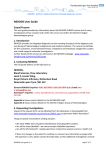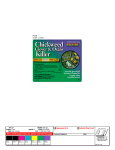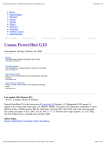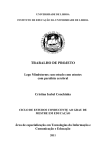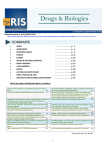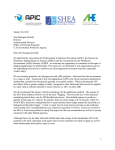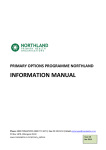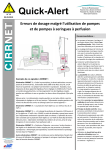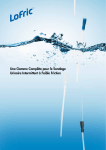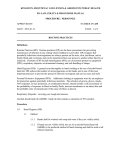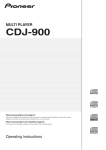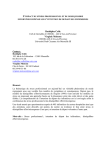Download catheter care guidelines 2013 - Canterbury District Health Board
Transcript
Canterbury Continence Forum Health Professionals Working in Partnership CATHETER CARE GUIDELINES 2013 CDHB Nursing Policies and Procedures Catheter Guidelines Contents ACKNOWLEDGEMENTS ........................................................................................ 3 THE CONTINENCE REFERRERS AND PROVIDERS FORUM.............................. 3 CATHETER CARE GUIDELINES ............................................................................ 4 RESPONSIBILITY OF HEALTH CARE WORKERS ................................................ 4 CONSENT ............................................................................................................... 4 DECISION TO CATHETERISE ................................................................................ 4 INDICATIONS FOR URINARY CATHETERISATION (but are not limited to) .......... 5 POSSIBLE COMPLICATIONS ................................................................................. 6 TERM OF CATHETERISATION (Intermittent, Short Term, Long Term) .................. 6 ASSESSMENT AND CATHETER SELECTION....................................................... 7 CATHETER TYPES ................................................................................................. 7 CHOICE OF CATHETER MATERIAL ...................................................................... 8 CHOICE OF CATHETER LENGTH ......................................................................... 9 CHOICE OF CATHETER SIZE/DIAMETER ............................................................ 9 CATHETER BALLOON SIZE ................................................................................. 10 CATHETER STORAGE ......................................................................................... 10 CATHETER DRAINAGE BAG SELECTION .......................................................... 10 INDICATIONS FOR SUPRAPUBIC CATHETERISATION ..................................... 12 CONTRAINDICATIONS FOR SUPRAPUBIC CATHTERISATION ........................ 13 CARE OF THE SUPRAPUBIC CATHETER .......................................................... 13 SUPRAPUBIC CATHETER CHANGE ................................................................... 14 CATHETER CHANGE PROCEDURES AND CATHETER COMFORT ................. 14 PERSONAL CARE................................................................................................. 15 BOWEL CARE ....................................................................................................... 15 FLUID INTAKE ....................................................................................................... 16 BLADDER WASHOUT ........................................................................................... 16 DOCUMENTATION ............................................................................................... 16 INFECTION PREVENTION AND CONTROL PRINCIPLES .................................. 17 WHEN A PATIENT IS BEING DISCHARGED ....................................................... 17 Appendix 1: MALE CATHETERISATION ............................................................... 19 Appendix 2: FEMALE CATHETERISATION .......................................................... 22 Appendix 3: SUPRAPUBIC CATHETER (SPC) CHANGE ..................................... 24 Ref: 4501 Authorised by: Clinical Nurse Specialist Page 2 of 45 July 2013 CDHB Nursing Policies and Procedures Catheter Guidelines Appendix 4: CLEAN INTERMITTENT CATHETERISATION IN THE COMMUNITY ............................................................................................................................... 27 Appendix 5: COLLECTION OF CATHETER SPECIMENS .................................... 29 Appendix 6: BLADDER WASHOUT ....................................................................... 31 Appendix 7: EMPTYING CATHETER BAGS ......................................................... 33 Appendix 8: CHANGING CATHETER BAGS IN HOSPITAL ................................. 34 Appendix 9: PROBLEM SOLVING ......................................................................... 35 Appendix 10: BLOCKING CATHETER FLOW CHART ......................................... 37 Appendix 11: BLADDER AND/OR URETHRAL SPASM FLOW CHART ............... 37 Appendix 12: URINE DOES NOT DRAIN FLOW CHART ...................................... 38 Appendix 13: URINE BY PASSING FLOW CHART ............................................... 40 Appendix 14: BALLOON DOES NOT DEFLATE FLOW CHART ........................... 40 REFERENCES....................................................................................................... 41 This document has been formulated in consultation with Continence Nurses, Urology Nurses, nurses working in the field of continence management and the medical staff from the department of Urology, Christchurch Hospital. ACKNOWLEDGEMENTS Andrea Lord, Nurse Consultant Anne Murray, Urology Unit Clinical Charge Nurse, Christchurch Hospital Di Poole, Continence Clinical Nurse Specialist, The Princess Margaret Hospital Jane Harvey, Continence Clinical Nurse Specialist Karen Betony, Clinical Nurse Educator, Nurse Maude Association Nicky Varcoe, Clinical Nurse Specialist, Urodynamic Unit, Burwood Spinal Unit Ruth Abrams, Urology Clinical Nurse Specialist, Christchurch Hospital Sharon English, Urologist Stephen Mark, Urologist Sue Chambers, Continence Clinical Nurse Specialist, Christchurch Hospital Val Sandston, Clinical Manager, Middlepark Rest home and Village THE CONTINENCE REFERRERS AND PROVIDERS FORUM Canterbury funders and providers working together to promote continence services for the population of Canterbury. The forum provides support and liaison among people and services involved in continence service provision, funding, research and education in Canterbury. Ref: 4501 Authorised by: Clinical Nurse Specialist Page 3 of 45 July 2013 CDHB Nursing Policies and Procedures Catheter Guidelines CATHETER CARE GUIDELINES These guidelines are based on current clinical practice in New Zealand and internationally, where possible supported by published research articles. The information contained in this document is strictly for guidance purposes and does not supersede individual institutions policy and procedure guidelines. Adherence to the instructions published by product manufacturers is strongly recommended. The authors take no responsibility for any adverse events incurred as a result of using information within this document. RESPONSIBILITY OF HEALTH CARE WORKERS To acquire adequate training to carry out the procedure (defined by place of work) - Self monitoring is required to ensure the skill of catheterisation is up to date Accurate assessment of specific clinical indication for catheterisation To minimize the trauma and infection risk associated with inserting and maintaining urinary catheters - Risk prevention: aseptic technique, competent staff and sterile equipment - Risk reduction: intermittent catheterisation instead of indwelling catheterisation To minimize psychological trauma to the patient Nurses need to know what type of catheter equipment is available and know the benefits and disadvantages of the catheter equipment used Nurses should ensure that all catheter equipment is used according to manufacturers guidelines and only be used for the purpose it was designed for (Royal College of Nurses, 2008) CONSENT To obtain consent for the procedure of catheterisation consent is required for all aspects of catheter care including catheter removal. Risks are explained in the process of consent, including blockage, discomfort, infection, bleeding and in men, painful erection Initial catheterisation should be in consultation with a medical practitioner DECISION TO CATHETERISE Most patients with long term indwelling urinary catheters experience some complications at some time, with many experiencing frequent and distressing complications so the decision to use catheters long term should only be taken after all other options have been explored and their use should be regularly reviewed. Ref: 4501 Authorised by: Clinical Nurse Specialist Page 4 of 45 July 2013 CDHB Nursing Policies and Procedures Catheter Guidelines Factors to consider prior to catheterisation Is there an alternative, less invasive method of management? History of haematuria and or discharge History of urethral obstruction or previous catheterisation History of recent surgery or malignancy to the lower urinary tract Congenital abnormalities affecting the pelvis Trauma of pelvis or abdomen Inflammation of the genitourinary tract, cystitis, urethritis, vaginal pain Immunocompromised patients Spinal cord injured patients due to risk of autonomic dysreflexia (ICS ,2009) INDICATIONS FOR URINARY CATHETERISATION (but are not limited to) Urinary drainage During surgical procedures and post operative care Urinary retention /bladder outlet obstruction Management of intractable incontinence where catheterisation will enhance the persons quality of life, used as a last resort when alternative non invasive methods are unsatisfactory (ICS ,2009) Comfort for the terminally ill Monitoring Accurate monitoring of urine output in acute care Urodynamic investigation Treatment To instill medication into the bladder Irrigate the bladder when haematuria is a concern (RCN,2008) To keep perineal area dry to assist healing in the presence of skin breakdown and or infection Precautions Patients with cognitive impairment Patients with existing heart valve/joint replacements - may require antibiotic cover Distortion of the urethra due to recent urethral/prostate surgery or trauma, urethral strictures Ref: 4501 Authorised by: Clinical Nurse Specialist Page 5 of 45 July 2013 CDHB Nursing Policies and Procedures Catheter Guidelines POSSIBLE COMPLICATIONS Inability to catheterise Catheter Associated Urinary Tract Infection (C.A.U.T.I.) Urethral injury: - Inflation of balloon before insuring correct catheter placement in the bladder - False Passage – by injury to the urethral wall during insertion Bladder calculi Bladder cancer (ICS, 2009) Haemorrhage – trauma sustained during insertion or balloon inflation Urethral strictures – following damage to the urethra long term problem Paraphimosis due to failure to return foreskin to normal position following catheter insertion (Blitz, 1995) Allergic reactions to soap, catheter materials, lubrication gel Psychological trauma TERM OF CATHETERISATION (Intermittent, Short Term, Long Term) Catheterisation can be divided into three groups according to the length of time in use. 1. Intermittent The catheter is inserted and removed immediately after emptying the bladder. The process of intermittently catheterising is described as Clean Intermittent Catheterisation (C.I.C.) or Clean Intermittent Self Catheterisation. Frequency of C.I.C. is based on individual need. Intermittent catheterisation can be used: If post void residual urine volumes are more than 100ml e.g. -acute urinary retention post surgery -neurological conditions that result in urinary retention Post surgical intervention -e.g. following Mitrofanoff procedure When medically indicated - to obtain a urine specimen - to check post void residual bladder volume If the concept of C.I.C. is acceptable to user (or carer) Sufficient dexterity and cognitive ability is necessary to manage regular drainage (ICS 2009) The Australian New Zealand Therapeutic Goods Authority (ANZTGA) has approved reuse of catheters in the home setting. In the community C.I.C. is a clean procedure and each catheter may be used for a week. Ref: 4501 Authorised by: Clinical Nurse Specialist Page 6 of 45 July 2013 CDHB Nursing Policies and Procedures Catheter Guidelines People who self catheterise should continue to do so if possible during hospitalisation. While in a hospital setting a new catheter should be used each time due to an increased risk of infection. 2. Short term catheterisation-up to 14 days (ICS, 2009) The Foley catheter is left in situ for up to two weeks e.g. in a pre-operative and immediate post operative period to monitor urinary output, or if medically indicated. An indwelling catheter (IDC) should be used for the minimum possible time. 3. Long term catheterisation - 2 weeks to 3 months The Foley catheter is left in situ for up 3 months. The catheter may be placed urethrally (IDC) or suprapubically (SPC) depending on the individual patient’s circumstances (Marsden Manual, 2001). An indwelling catheter (IDC) should be changed on an individual needs basis (Tenke et al 2008). This can vary dramatically from individual to individual e.g. if the catheter regularly blocks, a pattern may be identified and the catheter should be changed in accordance with that pattern (Miles & Schroeder, 2009). In accordance with the manufacturers’ recommendations for catheter usage, it is recommended that catheter changes are based on: Function of the catheter Degree of catheter encrustation Frequency of blockage Patient comfort ASSESSMENT AND CATHETER SELECTION Each patient's individual needs should be considered carefully when selecting a catheter. These include: Indication for catheterisation (APIC, 2008) Consistency of urine Anticipated duration of catheterisation Type of catheterisation i.e. urethral or suprapubic (ICS, 2009) CATHETER TYPES Nelaton catheter- in/out use e.g. Clean Intermittent Self Catheterisation Straight tip Straight tip Coude or Tiemann Specialist tip tip -Coude/Tiemann tip Acknowledgement Urol Nurses ©2011 Society of Urological Nurses and Associates Ref: 4501 Authorised by: Clinical Nurse Specialist Page 7 of 45 July 2013 CDHB Nursing Policies and Procedures Catheter Guidelines Foley indwelling catheter (IDC) – urethral or suprapubic (SPC) drainage (short term or long term use) A 2 way channel -most commonly used Three way catheter A 3 way channel - for bladder irrigation e.g. urine containing clot or debris Specialist tips - Malecot/ rounded /whistle tip CHOICE OF CATHETER MATERIAL Catheters are made of non toxic polyvinylchloride, latex, or silicone and these may have a silicone, hydrophilic or silver coating. All catheters should be used in accordance with manufacturers’ instructions and conform to the Australia New Zealand Therapeutic Products Agency (ANZTPA) standards. Nelaton catheter non toxic polyvinylchloride with hydrophilic and/or silicone coating Used for intermittent catheterisation Coated catheters may reduce urethral trauma and CAUTI (ICS, 2009) Foley Latex based/ silicone coated catheter Short term use-up to 6 weeks May be used for IDC/SPC Foley Latex based /Hydrogel coated catheter Long term use- up to 12 weeks May be used for IDC/SPC Foley Latex based/ Silver- alloy coated catheter Short term use- up to 2 weeks (Bard 2010) May be considered to reduce the risk of catheter associated infection, but further economic evaluations are required to determine cost benefit (ICS, 2009) May be used for IDC/SPC Foley 100% Silicone based catheter- Latex free Long term use- up to 12 weeks May be used for IDC/SPC Drainage lumen is wider and so may reduce the level of catheter encrustation and blockage Silicone catheters may be more rigid than latex catheters and less comfortable for the patient Silicone is semi permeable and the balloon may require re-inflating at regular intervals Ref: 4501 Authorised by: Clinical Nurse Specialist Page 8 of 45 July 2013 CDHB Nursing Policies and Procedures Catheter Guidelines On removal, the 100% Silicone catheter balloons may not deflate smoothly or completely, thus increasing the risk of urethral or SPC tract trauma (Medical Devices Agency, 2001) - see section on catheter removal re suggestions to minimize this occurrence Metal catheters- silver or stainless steel(less commonly used) Used for intermittent catheterisation CHOICE OF CATHETER LENGTH Catheters are available in 3 lengths: Paediatric Female length-20-25cm - a shorter length catheter may be more convenient for ambulant women with a long term catheter (IDC) - a ‘female’ length catheter should NEVER be used with a male patient (NPSA, 2009) N.B Only male length catheters should be used for suprapubic catheterisation, unless discussed with a Urologist Male length-40-45 cm - the use of ‘male’ or standard length catheters is acceptable in all patients, if that is their preference CHOICE OF CATHETER SIZE/DIAMETER The size or diameter of the catheter is measured in either Charrière (Ch) or French (Fr). Catheters range in size from 5-24 French gauge (Fr). Ideally select the smallest size possible that will drain adequately for its intended use. Use of a catheter with a larger Fr/Ch size increases the risk of bladder and/ or urethral spasm, leading to pain, ‘blockage’ or by passing of urine. If any of these symptoms occur, re-catheterisation with a smaller size should occur. Children require smaller paediatric catheters, generally until they reach puberty when they move into the adult sizes. General Guide Adults 12-16 Fr (ICS, 2009). To assist consistency of practice, the Canterbury Urologists have agreed that 16 Fr should be the catheter size of first choice in the community, however, Nurse Maude staff should adhere to their policy which focuses on individual care (Urology Dept, 2012) Suprapubic 16-20 Fr Haematuria 20-24 Fr Ref: 4501 Authorised by: Clinical Nurse Specialist Page 9 of 45 July 2013 CDHB Nursing Policies and Procedures Catheter Guidelines - a 3 way haematuria catheter should be used to allow for the option of continuous bladder irrigation without requiring a further catheter change. When not in use, the irrigating port should be spigotted CATHETER BALLOON SIZE Foley catheters are retained in the bladder by a balloon, filled with sterile water. The balloon sizes range from 5-30 mls. The smaller 10 ml balloon size is recommended for all adults to minimize the risk of discomfort and bladder irritation (ICS, 2009). The balloon should be fully inflated to the recommended volume indicated on the packaging and inflation valve of the catheter. A 10ml balloon should be filled with between 7-10mls of sterile water The amount of water inserted should be documented Improperly inflated balloons may cause drainage and deflation difficulties Testing the balloon by inflating the balloon prior to insertion is not required (Bard, 2003) CATHETER STORAGE Catheters should be stored flat, in original packaging, out of direct sunlight and NOT bundled tightly together with rubber bands. Check expiry date before use. CATHETER DRAINAGE BAG SELECTION Adherence to a sterile continuously closed method of urinary drainage has been shown to markedly reduce the risk of acquiring a Catheter Associated Urinary Tract Infection (CAUTI) (ICS, 2009). Selecting a system involves: Indications for catheterisation The intended duration Infection control issues Wishes of the patient Mobility of patient Dexterity of patient e.g. ease of emptying bag with differing outlets Variety of catheter bag outlet types Acknowledgement International Continence Society 2009 Ref: 4501 Authorised by: Clinical Nurse Specialist Page 10 of 45 July 2013 CDHB Nursing Policies and Procedures Catheter Guidelines Patients should be made aware of the importance of hand washing both before and after handling the catheter drainage system. Leg bags (500-750 mls) Leg bags should be sterile and left in situ to minimise the risk of introducing infection between the catheter and bag connection point Drainage bags must have either an anti-reflux valve or anti-reflux chamber to prevent reflux of contaminated urine from the bag into the tubing It is recommended that drainage bags should have a sample/access port for the collection of urine specimens while maintaining a closed system, preferably needle-free Most commonly they are disposed and discarded after 1 week, however latex based leg bags can be used for longer periods of time Used during the day and secured to the leg in a variety of ways e.g. leg straps, leggi fix or catheter bag holders strapped from the waist - the belly bag may be placed upon the abdomen Legs bags must be kept below the level of the bladder, some people may choose to wear the leg bag on their thigh; others prefer to wear the leg bag on their calf Leg bags can also be used to reduce trauma for the confused or forgetful patient while in hospital Drainage tubing on leg bags is available in different lengths and can be tailored to individual’s requirements The leg bag should only be disconnected from the catheter when the bag is due to be changed or when the catheter needs changing At night a larger capacity bag is attached to the bottom of the leg bag, providing a link system and allowing for greater drainage (Stewart, 1998) The general recommendation for changing disposable drainage bags is weekly or when they become damaged, odorous or have sediment in the bottom (www.nhshealthquality.org 2004) Disposable 2 litre plastic bags (night bag) For general use in hospital and described as a night bag in the community Night bags have longer (120cm) length tubing commonly with an outlet port to allow emptying Bags should be changed when they become damaged, contaminated or malodorous and at catheter changes (www.nhshealthquality.org 2004) In the community the night bag is emptied and can be washed with warm water and mild detergent between uses; however, there is no strong evidence to support the benefits of doing this Disposable 2 litre closed system bag (hourly measuring bag) with sample port Used when frequent measurement of urine output is indicated. Ref: 4501 Authorised by: Clinical Nurse Specialist Page 11 of 45 July 2013 CDHB Nursing Policies and Procedures Catheter Guidelines Disposable 4 litre plastic bags Bags with non returnable valves Used post operatively in urology and for bladder irrigation Usually short term and only changed if damaged, contaminated or malodorous (Wong, 2001) CATHETER VALVES A catheter valve is a small device connected to the catheter in place of a drainage bag. Closing and opening of the valve allows for bladder filling and intermittent bladder emptying rather than continuous drainage into a bag. It can be released when the patient wishes to pass urine i.e. every 3-5 hours. The catheter valve can be connected to night drainage bag and opened to allow free drainage overnight. Catheter valves must be changed in accordance with the manufacturers’ recommendations. Valves are generally inappropriate after certain types of surgery e.g. radical prostatectomy and for patients with: Poor mobility Poor bladder capacity Detrusor overactivity Ureteric reflux Renal impairment Cognitive impairment (ICS ,2009) A spigot is not a suitable alternative to a valve as it has to be removed from the catheter to allow drainage and thereby breaking the closed drainage system. N.B New drainage bags and valves should be used when a catheter is changed. INDICATIONS FOR SUPRAPUBIC CATHETERISATION For some patients the insertion of an indwelling catheter suprapubically into the bladder, through the abdominal wall, offers advantages over the urethral route. Suprapubic catheterisation may be necessary following: Urethral trauma e.g. urethral stricture Pelvic trauma In most cases the suprapubic cystotomy is a temporary measure. Suprapubic catheterisation also offers advantages in: Acute care Ref: 4501 Authorised by: Clinical Nurse Specialist Page 12 of 45 July 2013 CDHB Nursing Policies and Procedures Catheter Guidelines - facilitation of post-surgical trial of voiding, by temporarily clamping the suprapubic drainage tubing Long-term care - for those who are sexually active, in a wheelchair, or have restricted hip mobility, or experience urethral pain - frail elderly men to avoid urethritis, orchiepididymitis and prostatitis - those prone to infection e.g. diabetes mellitus, faecal incontinence CONTRAINDICATIONS FOR SUPRAPUBIC CATHTERISATION Although suitable for a wide variety of patients, they are inappropriate with: Obesity or immobility- the traditional stoma site may become concealed by an apron of excess anterior abdominal wall fatty tissue making sitting and changing catheters problematic Haematuria of unknown origin Bladder tumours Small contracted or fibrotic bladders- which may have resulted from long-term urethral catheterisation on free drainage (ICS, 2009) CARE OF THE SUPRAPUBIC CATHETER Although the principles of care and management of the suprapubic catheter are similar to those of a urethral catheter, there are differences. Patients with a spinal injury may be at risk of autonomic dysreflexia, secondary to their injury. All staff must recognize signs of Autonomic Dysreflexia (kept with each patient) - refer to Burwood Spinal Unit manual for signs and symptoms and intervention Strategies to support the SPC may be required, e.g. anchoring to the abdominal wall, to prevent traction and potential displacement of the catheter or balloon Urine may still leak via the urethra especially if the catheter is blocked or the drainage tube kinked Immediately following insertion of a SPC, aseptic technique should be employed to clean the insertion site. Dressings may be required if secretions soil clothing, but they are not essential Once the insertion site has healed (7-10 days), the site and catheter can be cleaned using soap and water and a clean cloth (Royal Marsden Manual, 2008). Cleaning should be directed away from the insertion site. Talcum powder, creams and strongly perfumed soaps should be avoided Overgranulation of the site may occur. A hydrocortisone based steroid cream is the preferred treatment, e.g. Pimafucort for 5-7 days. If the overgranulation is quite proud Silver Nitrate can be used on a PRN basis to cauterise the tissue until the tissue has completely sloughed Ref: 4501 Authorised by: Clinical Nurse Specialist Page 13 of 45 July 2013 CDHB Nursing Policies and Procedures Catheter Guidelines SUPRAPUBIC CATHETER CHANGE A new suprapubic tract usually takes between 10 days and 4 weeks to become established, after which time the catheter may be changed safely. The first SPC change must be performed at 4-6 weeks by a doctor or by a specialised urology nurse who is experienced in this procedure. Burwood Spinal Unit recommends the first change at four weeks. Long term suprapubic catheters should be changed on an individual needs basis once the suprapubic tract has healed. This can vary dramatically from individual to individual e.g. if the catheter regularly blocks, a pattern may be identified and the catheter can be changed in accordance with that pattern. Some patients may have their catheter changed in accordance with Burwood Spinal Unit protocol which is once every two weeks to reduce the likelihood of complication due to potential catheter blockage .i.e. dysreflexia. The catheter must be replaced immediately if it falls out because the bladder/stoma alignment will become misaligned within 20 minutes and the abdominal stoma opening may close over within 24 hours. Patients should have a spare Foley and Nelaton catheter (the same size/ gauge that the patient uses) available at all times in case of emergencies. Suprapubic catheters must be changed in accordance with the manufacturers’ recommendations for catheter usage. Once efficient urethral drainage has been instituted the catheter can be withdrawn and the fistula will close rapidly (Peate, 1997). CATHETER CHANGE PROCEDURES AND CATHETER COMFORT Use of local anaesthetic Catheter related pain or discomfort can occur as the catheter is introduced, in situ or upon removal. Local anaesthetic lubricant gels are commonly used to aid the insertion of indwelling catheters in males and minimize trauma. Similar use of anaesthetic gel is generally recommended for females (ICS, 2009). Anaesthetic gels may be contraindicated in patients with damage or bleeding urethral membranes and used with caution in those with cardiac conditions, hepatic insufficiency and epilepsy (ISC, 2009). Note: due to the reports of adverse reactions, the Urological Society of Australia and New Zealand recommend the use of Chlorhexidine free Lignocaine gel wherever possible (USANZ, 2009). If bladder spasm is the cause of catheter related pain a low dose of an anticholinergic medication can help (ICS 2009). Ref: 4501 Authorised by: Clinical Nurse Specialist Page 14 of 45 July 2013 CDHB Nursing Policies and Procedures Catheter Guidelines Catheter change – urethral or suprapubic Protocols on indwelling catheter change frequency can vary widely from two weekly to up to 3 months if the catheter is trouble free. In the absence of clear supporting evidence this remains an area of controversy. There are two differing approaches early change vs. a longer change interval. More frequent changes reduce incidence of complications but increase risk of infection/trauma and long term histological changes, as well as use of increased resources. Leaving a catheter in place until it blocks has significant impact upon both the patient and family as well as placing unplanned demand upon health care services. Catheters should not remain in situ beyond the manufacturers recommended guidelines (RCN, 2008) -up to 12 weeks for silicone and hydrophilic coated Latex Foley catheters. The only clinical indications to change a catheter sooner are: infection, obstruction, or when the closed system is compromised (Gould et al, 2010). Approximately 50% of catheterised patients are prone to developing encrustation leading to catheter blockage, some patients blocking within days, others after several weeks (Getliffe, 1994). Catheter changes – based on an individualised plan All current best practice evidence strongly advocates the development of an individualised plan of care to determine the choice of catheter and drainage system to be used, and the frequency of catheter change (Tenke et al, 2008). This plan should aim to prevent the complications associated with long term catheterisation and should incorporate the patients abilities, personal preferences and tendency for catheter to block (Miles, 2009) Most patients’ pattern can be established within 3-6 catheter changes and catheter changes should be planned for several days prior to the likely time of blockage (Miles, 2009) Review the need for continued use of an indwelling catheter. All patients should have an ongoing review in consultation with the GP/Consultant, patient and family of all aspects of their catheter care, especially of the need for continuing with long term catheterisation (APIC, 2008), to meet their individual needs PERSONAL CARE Daily warm soapy water is sufficient for meatal care or prn if build-up of secretions is evident. Uncircumcised men should gently ease down foreskin over catheter after cleaning. BOWEL CARE Good bowel care involves assessment of normal bowel habit, avoiding constipation and straining, and discussing dietary intervention. The use of antispasmodic drugs e.g. oxybutynin, for catheter related bladder irritation, may contribute to constipation and decreased gastrointestinal motility (Medsafe, 2010). Straining in association with Ref: 4501 Authorised by: Clinical Nurse Specialist Page 15 of 45 July 2013 CDHB Nursing Policies and Procedures Catheter Guidelines emptying bowels contributes to bladder spasm, catheter bypassing and catheter blockage. FLUID INTAKE To assist in maintenance of catheter patency, a general recommendation is 1-1.5 litres fluid intake daily (ICS, 2009). However, the amount of fluid intake recommended for an individual needs to be considered in the context of that individual’s medical status and physiological requirements (Getliffe, 1994). Drinking orange juice or other fruit juices such as lemon or lime has been shown to increase time to catheter blockage (ICS, 2009). BLADDER WASHOUT The use of bladder washouts remains controversial. Bladder instillations or washouts consist of the instillation of a solution into the bladder via a catheter (Holtom, 2003). Breaking the closed system to perform a bladder washout will increase the risk of infection. If a bladder washout has to be performed an aseptic technique must be followed. Whilst evidence fails to demonstrate any beneficial effect from irrigation, instillation or washout, intermittent irrigation may be indicated during urological surgery or to manage catheter obstruction (Moore et al, 2009). Nurses should aim to assess individual patients' 'pattern of catheter life' and plan changes accordingly rather than wait until a catheter blocks. The Burwood Spinal Unit uses the method of bladder washout to minimize the likelihood of catheter blockage, particularly important for those patients at risk of Autonomic Dysreflexia. Patients who follow the Spinal Unit catheter protocol perform bladder washouts weekly if the patient is well. If a spinal injured patient’s catheter blocks it must be changed immediately. Currently in New Zealand there are no licensed catheter maintenance solutions available for use (e.g. “Suby G”). DOCUMENTATION Details regarding the catheterisation should be recorded in the patient’s notes. For further information please refer to your healthcare organizational policy and procedure manual. Patient details Procedure documented in the patient's medical records and signed by the person inserting the catheter Indication for catheterisation Time and date of catheterisation Catheter details and balloon size - type e.g Hydrogel/lubricious coated, silicone Ref: 4501 Authorised by: Clinical Nurse Specialist Page 16 of 45 July 2013 CDHB Nursing Policies and Procedures Catheter Guidelines - size - balloon size/ amount of water instilled in balloon - batch number and expiry of catheter Any problems with insertion Description of urine, colour and volume drained Specimen collected as clinically indicated Expected date of next and/or subsequent catheterisation, where this will take place, and by whom. (Marsden Manual, 2008) INFECTION PREVENTION AND CONTROL PRINCIPLES Catheterisation of the urinary tract should only be performed when there is a specific and adequate clinical indication, as catheterisation carries a high risk of infection. Adherence to a sterile continuously closed method of urinary drainage has been shown to markedly reduce the risk of acquiring a catheter associated infection. Strict aseptic technique is essential. Hand hygiene is the primary defense against cross infection. Bacteriuria secondary to insertion of a catheter occurs in 20- 30 % of patients. The risk of infection is related to the method of insertion, duration of catheterisation, quality of catheter care and patient susceptibility (Department of Health, 2001). Standard Precautions are maintained when in contact with urine and /or other body fluids. Gloves are changed after each procedure and between patient contact. Hand hygiene should be performed in accordance with the 5 Moments for Hand Hygiene. Gravity is important for drainage and the prevention of urine backflow. Ensure that catheter bags are always draining downwards, do not become kinked and are secured below thigh level. Metal or plastic hangers should be attached to the side of the bed. Cloth bags tied to the bed to support the bags are also available. Cloudy, offensive smelling or unexplained blood-stained urine is not normal and needs further intervention. A urine specimen for culture is taken only when clinically indicated. An aseptic technique is used. If cultured, most urine from patients with an indwelling urinary catheter would show a degree of bacteria. These catheter-associated urinary tract infections in otherwise healthy patients are often asymptomatic, and likely to resolve spontaneously when the catheter is removed (Wong, 2001). If a patient is commenced on a course of antibiotics catheter change is mandatory. Prophylactic antibiotic cover for indwelling catheters is rarely necessary. WHEN A PATIENT IS BEING DISCHARGED The patient and or family/whanau should be given the following information: Patient handout "You and Your Catheter " Ref: 4501 Authorised by: Clinical Nurse Specialist Page 17 of 45 July 2013 CDHB Nursing Policies and Procedures Catheter Guidelines Copy of documentation required for the health provider responsible for ongoing catheter care outlining the indication for catheterisation, type of catheter (e.g. Hydrogel/silicone), balloon size, amount of water instilled in the balloon, any problems with insertion, expected date of next and/or subsequent catheterisation, where this will take place, and by whom Who to contact if problems arise, acute and non-acutely Ref: 4501 Authorised by: Clinical Nurse Specialist Page 18 of 45 July 2013 CDHB Nursing Policies and Procedures Catheter Guidelines Appendix 1: MALE CATHETERISATION This procedure is based on the Royal Marsden Hospital Manual and can be used as a guide only. Please refer to your healthcare organizational policy and procedure manual. Standard precautions and principles of asepsis to be used. Ensure a good light source is available and ensure patient privacy and keep warm at all times. Providing a clean working surface such as a trolley to set up catheterisation equipment is ideal. Equipment required Sterile catheterisation pack Disposable pad Sterile gloves Appropriate size Foley catheter Sterile anaesthetic lubricating jelly - Lignocaine gel syringe - ideally Chlorhexidine free 0.9% sodium chloride or antiseptic solution-for cleaning Alcohol-based hand rub Sterile water for the balloon Syringe Disposable plastic apron Leg strap or tape to secure the catheter to the leg Sterile drainage bag or catheter valve Urine bag holder if required Urine Specimen jar if required Procedure 1. Perform hand hygiene 2. Discuss procedure with patient and gain verbal consent 3. Ensure patient privacy and keep warm at all times 4. Assist patient into the supine position with legs extended a. place a waterproof sheet under buttocks b. do not expose the patient at this stage of procedure (If unable to lay supine a lateral position with 1-2 pillows between legs is suitable) 5. Wash hands with antimicrobial liquid soap or alcohol-based hand rub (ABHR) 6. Put on plastic apron 7. Prepare equipment a. if using trolley place all equipment required on bottom shelf b. take trolley to patient’s bedside 8. Open outer cover of catheterisation pack and slide the pack onto top shelf of trolley a. open up pack using an aseptic technique Ref: 4501 Authorised by: Clinical Nurse Specialist Page 19 of 45 July 2013 CDHB Nursing Policies and Procedures Catheter Guidelines b. add catheter and other sterile equipment- gloves, syringes ,sterile leg bag or catheter valve, anaesthetic gel c. pour sterile water (for balloon) and 0.9% sodium chloride (for cleaning), into tray compartments 9. Remove bed sheet/cuddly/cover that is maintaining patient’s privacy 10. Wash hands with antimicrobial liquid soap or alcohol-based hand rub (ABHR)and put on sterile gloves 11. Place sterile drape across patient’s thighs, the fenestrated plastic sheet is placed with the hole over the penis a. connect sterile catheter to sterile drainage bag or catheter valve whilst on sterile field b. fill inflation syringe with 10 ml of sterile water c. prepare anaesthetic gel syringe and lubricate tip of catheter 12. With your non-dominant hand wrap a sterile gauze swab around penis and lift the penis (this hand is now considered contaminated and should maintain a firm grasp until the procedure is completed) a. if non-circumcised retract the foreskin b. using your other hand, clean the meatus with gauze swabs and 0.9% sodium chloride (or antiseptic solution). Use a circular motion, moving from the meatus to the base of the penis 13. Insert the nozzle of the anaesthetic lubrication jelly into the urethra. Slowly squeeze the gel into the urethra a. once instilled, hold the distal urethra closed and using the barrel of the syringe massage the gel along the urethra (on the underside of the penis) b. wait 2 -5 minutes to give the gel time to work (if post-urology surgery consider using two syringes) 14. Grasp the penis with slight upward tension and perpendicular to the patient's body and maintain the grasp of the penis until the procedure is finished a. insert the catheter into meatus with your dominant hand and gently continue insertion of catheter 15. When the first sphincter is reached (at level pelvic floor muscle), lower the penis 90 degrees (facing patient’s toes) 16. If resistance is felt, DO NOT USE FORCE AS YOU MAY DAMAGE THE URETHRA a. consider 2nd tube of lubricant b. increase the traction on the penis and apply gentle pressure on the catheter c. ask the patient to take a deep breath or to cough or to try to pass urine d. gently rotate the catheter 17. Continue to advance the catheter to the bifurcation junction, observe urine flow Bifurcation junction Ref: 4501 Authorised by: Clinical Nurse Specialist Page 20 of 45 July 2013 CDHB Nursing Policies and Procedures Catheter Guidelines If urine does not flow immediately lignocaine gel may be causing blockage, in which case a flush may be required. 18. Inflate the balloon slowly using sterile water to the volume recommended on the catheter. (Bard 2001) a. always ensure urine is flowing before inflating the balloon, checking that no pain is felt by the patient b. if there is pain, it could indicate the catheter is not in the bladder 19. Withdraw the catheter slightly, until resistance is felt a. if not already attached, connect the sterile drainage system to the catheter b. if a specimen of urine is obtained immediately following the insertion of an IDC, before the catheter bag is attached, the urine can drain directly into the specimen container 20. Secure the catheter to the thigh with additional leg strap or tape 21. Ensure that the catheter bag is well supported and draining below bladder level 22. Reposition the foreskin if applicable 23. Ensure the patient is left dry and comfortable 24. Remove gloves and dispose of equipment in a yellow biohazard bag 25. Wash hands with antimicrobial liquid soap or alcohol-based hand rub (ABHR) 26. Record information pertaining to reason for catheterisation, type of catheter, expected change date etc. into relevant documents Watch point Post Obstructive Diuresis may require IV replacement of electrolytes (Walker 1990). This will occur with patients with renal impairment and they require hospital admission and close observation. Ref: 4501 Authorised by: Clinical Nurse Specialist Page 21 of 45 July 2013 CDHB Nursing Policies and Procedures Catheter Guidelines Appendix 2: FEMALE CATHETERISATION This is based on the Royal Marsden Hospital Manual and can be used as a guide only. Please refer to your healthcare organizational policy and procedure manual. Standard precautions and principles of asepsis to be used. Ensure a good light source is available and ensure patient privacy and keep warm at all times. Providing a clean working surface such as a trolley to set up catheterisation equipment is the ideal. Equipment required Sterile catheterisation pack Sterile gloves Appropriate size Foley catheter Sterile lubricating or anaesthetic lubricating gel 0.9% sodium chloride or antiseptic solution-for cleaning Alcohol-based hand rub Sterile water for the balloon Syringe Disposable plastic apron Leg strap or tape to secure the catheter to the leg Sterile drainage bag or catheter valve Urine bag holder if required Urine Specimen jar if required PROCEDURE 1. Perform hand hygiene 2. Discuss procedure with patient and gain verbal consent 3. Ensure patient privacy and keep warm at all times 4. Assist patient into the supine position with legs extended a. place a waterproof sheet under buttocks b. do not expose the patient at this stage of procedure 5. Wash hands with antimicrobial liquid soap or alcohol-based hand rub (ABHR). 6. Put on plastic apron 7. Prepare equipment-if using trolley place, all equipment required on bottom shelf a. take trolley to patient’s bedside 8. Open outer cover of catheterisation pack and slide the pack onto top shelf of trolley a. open up pack using an aseptic technique b. add catheter and other sterile equipment-gloves, syringe ,sterile leg bag or catheter valve, lubricating gel c. pour sterile water (for balloon) and 0.9% sodium chloride (for cleaning), into tray compartments 9. Remove bed sheet/cuddly/cover that is maintaining patient’s privacy Ref: 4501 Authorised by: Clinical Nurse Specialist Page 22 of 45 July 2013 CDHB Nursing Policies and Procedures Catheter Guidelines a. assist pt into the supine position with knees bent, hips flexed and feet resting about 60 cm apart 10. Wash hands with antimicrobial liquid soap or alcohol-based hand rub (ABHR) and put on sterile gloves 11. Place sterile drapes across patient’s thighs and the fenestrated drape (drape with central access hole) is placed over the urethral orifice a. connect sterile catheter to sterile drainage bag or catheter valve whilst on sterile field b. fill inflation syringe with 10 ml of sterile water c. prepare anaesthetic gel syringe and lubricate tip of catheter 12. With your non-dominant hand, separate the labia minora to expose the urethral meatus (this hand is now considered contaminated and should remain in this position until the procedure is completed). 13. Using gauze swabs clean both the labia folds and the urethral meatus a. move swabs from above the meatus down towards the rectum b. discard each swab after each downward stroke 14. With dominant hand, insert the catheter into the meatus, upward at approx 30 degree angle until urine begins to flow 15. Advance the catheter as far as comfortably possible (approx 6-8 cm) to avoid inflating the balloon in the urethra 16. Inflate the balloon slowly using sterile water to the volume recommended on the catheter (Bard 2001) a. always ensure urine is flowing before inflating the balloon, checking that no pain is felt by the patient 17. Withdraw the catheter slightly, until resistance is felt a. if not already attached, connect the sterile drainage system to catheter b. if specimen of urine is obtained immediately following the insertion of an IDC, before the catheter bag is attached, the urine can drain directly into the specimen container 18. Secure the catheter to the thigh with additional leg strap or tape 19. Ensure that the catheter bag is well supported and draining below bladder level 20. Ensure the patient is left dry and comfortable 21. Remove gloves and dispose of equipment in a yellow biohazard bag 22. Wash hands with antimicrobial liquid soap or alcohol-based hand rub (ABHR) 23. Record information pertaining to reason for catheterisation, type of catheter, expected change date etc into relevant documents Watch point Post Obstructive Diuresis may require IV replacement of electrolytes (Walker 1990). This will occur with patients with renal impairment and they require hospital admission and close observation. Ref: 4501 Authorised by: Clinical Nurse Specialist Page 23 of 45 July 2013 CDHB Nursing Policies and Procedures Catheter Guidelines Appendix 3: SUPRAPUBIC CATHETER (SPC) CHANGE This is based on the BURWOOD SPINAL UNIT PROTOCOL and can be used as a guide only. Please refer to your healthcare organizational policy and procedure manual. Standard precautions and principles of asepsis to be used. Ensure a good light source is available and ensure patient privacy and keep warm at all times. Providing a clean working surface such as a trolley to set up catheterisation equipment is the ideal. The catheter must be replaced immediately if it falls out (the bladder/stoma alignment will become misaligned within 20 minutes and the abdominal stoma opening may close over within 24 hours). A spare Foley and Nelaton catheter (of the same size or gauge) must be available at all times. The Spinal Unit Protocol recommends weekly washout and fortnightly catheter change. A bladder washout may be performed after a catheter change. EQUIPMENT REQUIRED Catheter pack Hydrogel or Silicone Foley catheter of same replacement size – 16 -18 Ch/Fg Alcohol-based hand rub One pair of sterile gloves and one pair clean gloves 0.9% sodium chloride or antiseptic solution –for cleaning. Two 10 ml syringes Sterile water 10 ml (to inflate catheter balloon) Water based soluble lubricant or anaesthetic lubricating gel Drainage bag or catheter valve Leg strap or tape to secure the catheter to the leg Scissors Disposable waterproof sheet Receptacle for “dirty swabs” “old” catheter Disposable plastic apron Urine Specimen jar if required PROCEDURE 1. Perform hand hygiene 2. Discuss procedure with patient and gain verbal consent a. ensure patient privacy and keep warm at all times b. the patient may require some pain control/antispasmodic medication prior to procedure, due to discomfort secondary to bladder spasm Ref: 4501 Authorised by: Clinical Nurse Specialist Page 24 of 45 July 2013 CDHB Nursing Policies and Procedures Catheter Guidelines c. check whether patient is feeling well enough for SPC change, if not reschedule SPC change (Burwood Spinal Unit patients only) 3. Position the patient lying on their back with SPC insertion site exposed place waterproof sheeting between nurse and patient. 4. Wash hands with antimicrobial liquid soap or alcohol-based hand rub (ABHR) 5. Put on plastic apron 6. Prepare equipment-if using trolley place, all equipment required on bottom shelf a. take trolley to patient’s bedside 7. Open outer cover of catheterisation pack and slide the pack onto top shelf of trolley 8. Open up pack using an aseptic technique a. add catheter and other sterile equipment-gloves, syringes ,sterile leg bag or catheter valve, anaesthetic gel b. pour sterile water (for balloon) and 0.9% sodium chloride (for cleaning), into each tray compartment 9. Using clean gloves remove dressing from site 10. Wash hands with antimicrobial liquid soap or alcohol-based hand rub (ABHR) and put on sterile gloves. 11. Place sterile drapes across patient’s thighs and the fenestrated drape (drape with central access hole) is placed over the suprapubic stoma/site a. connect sterile catheter to sterile drainage bag or catheter valve whilst on sterile field b. fill inflation syringe with 10 ml of sterile water c. lubricate tip of catheter 12. Clean around catheter site thoroughly using cleaning solution and a new swab each time. 13. It is suggested that inserting gel into the tract makes catheterisation easier 14. With your non-dominant hand wrap a sterile swab around “old” catheter inflation lumen port (this hand is now considered contaminated and should maintain a firm grasp until the procedure is completed) a. using empty 10 ml syringe, deflate balloon gently and unhurriedly b. note how far in the “old” catheter was placed and/or length of discoloration of “old” catheter. 15. Pick up the pre-lubricated catheter with dominant and align catheter alongside “old catheter”, ensuring sterility of catheter is not compromised 16. With non-dominant hand gently remove ”old” catheter (you may feel some mild resistance) and with dominant hand insert “new catheter “ at the same angle and depth in as the ”old catheter” 17. Do not take the catheter out unless it is going to be reinserted immediately 18. Wait for some urine to flow from the catheter (may take a few minutes if a routine catheter change) 19. Once there is urine draining from the catheter a. inflate the balloon using 7– 10 mls of sterile water b. apply gentle traction, the catheter should retract slightly and then remain in situ Ref: 4501 Authorised by: Clinical Nurse Specialist Page 25 of 45 July 2013 CDHB Nursing Policies and Procedures Catheter Guidelines c. if it is immobile the catheter may be in the urethra, deflate balloon and withdraw slightly, if urine drains, re-inflate balloon and try retraction test again 20. Secure the catheter to the thigh/abdomen with additional leg strap or tape 21. Place sterile gauze swab around SPC site and tape in place 22. Ensure that the catheter bag is well supported and draining below bladder level 23. Take a urine specimen for laboratory examination, if required a. if a sterile bag has been used, specimen can be taken from the bag on this occasion 24. Ensure the patient is left dry and comfortable 25. Remove gloves and dispose of equipment in a yellow biohazard bag 26. Wash hands with antimicrobial liquid soap or alcohol-based hand rub (ABHR) 27. Record information pertaining to reason for catheterisation, type of catheter, expected change date etc into relevant documents Ref: 4501 Authorised by: Clinical Nurse Specialist Page 26 of 45 July 2013 CDHB Nursing Policies and Procedures Catheter Guidelines Appendix 4: CLEAN INTERMITTENT CATHETERISATION IN THE COMMUNITY These guidelines are for patients performing the procedure themselves. Please refer to your healthcare organizational policy and procedure manual. Catheterisation should be done when the bladder feels full. If there is no sensation of bladder fullness, catheterisation should be done on waking, 2-3 times during the day and just before going to bed. The volumes drained off should be checked to ensure that the bladder is not holding more than 300-400ml. If the volumes are more than this then catheterisation may need to be done more frequently. Equipment required Nelaton catheter Alcohol-based hand rub Water based soluble lubricant or anaesthetic lubricating gel Toilet tissue or wet wipes Container for collecting urine if not using the toilet Mirror Torch or lamp A female length catheter is recommended for most women. However, for those who are bedridden, chair bound, or obese, a longer male length catheter connected to a drainage bag may enhance their ability to perform the procedure. Procedure 1. Perform hand hygiene 2. Set up equipment on a clean, easily accessible surface a. ensure catheter is within reach b. open lubricant 3. Assume comfortable position. This may be lying on the bed, sitting on the toilet or wheelchair or standing over the toilet. A mirror can be used initially to aid the localisation of the urinary meatal opening but is recommended that the palpation method be used rather than relying on a mirror 4. Remove the catheter from the clean container or packet, taking care not to touch the end that will be inserted Female Separate labia and gently cleanse with downward strokes Apply lubricant to the insertion end of the catheter. Part the labia with the non dominant hand, hold the catheter in the other hand and gently insert the catheter into the urethra. Direct the catheter upward until urine flows Ref: 4501 Authorised by: Clinical Nurse Specialist Page 27 of 45 July 2013 CDHB Nursing Policies and Procedures Catheter Guidelines Male With one hand grasp the penis at right angles from the body and cleanse using a circular motion, moving from the meatus to the base of the penis Retract the penis if uncircumcised. Apply lubricant to the insertion end of the catheter. Hold the penis perpendicular to the body; insert the catheter with firm, gentle pressure. Some resistance may be felt at the prostatic urethra/ bladder sphincter. If firm, gentle pressure does not overcome the resistance; wait momentarily until the sphincter muscle relaxes. Breathing deeply, relaxing and reapplying gentle firm pressure and maintaining the penis in the perpendicular position will help. Never force the catheter 5. Let the urine pass into the toilet or container, leaving the catheter in place until all the urine has drained 6. When urine stops flowing, slowly withdraw the catheter. If more urine starts to flow stop withdrawing the catheter until the urine stops. Remove catheter 7. Clean the catheter by rinsing it under clean running water, tip end upward. Shake dry and store in a clean, dry, sealed container. The catheter can be used for one week and then thrown away. The container should be changed or cleaned once a week 8. Wash hands with antimicrobial liquid soap or alcohol-based hand rub (ABHR) Ref: 4501 Authorised by: Clinical Nurse Specialist Page 28 of 45 July 2013 CDHB Nursing Policies and Procedures Catheter Guidelines Appendix 5: COLLECTION OF CATHETER SPECIMENS This procedure is based on the Royal Marsden Hospital Manual and can be used as a guide only. Please refer to your healthcare organizational policy and procedure manual. Standard precautions and principles of asepsis to be used. Indications: Signs and symptoms of a urinary tract infection (IDC in situ) The patient has an indwelling catheter and at least two of the following signs and symptoms: Fever (>38°C) or chills New or increased burning pain (dysuria) on urination, frequency or urgency New flank or supra pubic pain or tenderness Change in character of urine Worsening of mental or functional status (McGeer et al, 1991) Ideally catheter bags with needless sample/ access ports should be used and disconnection of the catheter bag is not recommended. Equipment required Isopropyl Alcohol 70% swab Alcohol-based hand rub Non-sterile gloves Sterile Syringe– barrel nozzle (and needle if not a needle-free system) Gate clip or “quick clamp” Urine Specimen container Procedure 1. Perform hand hygiene 2. Discuss procedure with patient and gain verbal consent 3. Clamp drainage tube just below the catheter/drainage bag connection, until urine collects 4. Wash hands with antimicrobial liquid soap or alcohol-based hand rub (ABHR ) and put on sterile gloves 5. Clean access point with swab saturated with 70% Isopropyl Alcohol using firm friction and allow to air dry 6. Insert sterile syringe directly into sample port and aspirate 3ml urine, a minimum of 1 ml is required for satisfactory testing (Laker, 1995), the port will self-seal when the syringe is withdrawn. Or if using needle and syringe, insert needle at a 45o angle into the catheter above the clamp (avoiding the water channel to the balloon) 7. Disconnect the needle from the syringe and carefully empty urine filled syringe into specimen container 8. Discard needle and syringe into sharps container 9. Wipe the sample port or access area with alcohol swab 10. Release catheter clamp Ref: 4501 Authorised by: Clinical Nurse Specialist Page 29 of 45 July 2013 CDHB Nursing Policies and Procedures Catheter Guidelines 11. Remove gloves and dispose of equipment in a yellow biohazard bag 12. Wash hands with antimicrobial liquid soap or alcohol-based hand rub (ABHR) 13. Label specimen container with patient details, specimen type, date and time of collection a. place in biohazard bag and seal b. complete lab form, note in particular patient symptoms and if on antibiotic therapy 14. Arrange for transport to the laboratory or refrigerate sample 15. Document in patient record rationale for collection of urine sample, date and time taken Needleless Access /Sample port or urine specimens Ref: 4501 Authorised by: Clinical Nurse Specialist Page 30 of 45 July 2013 CDHB Nursing Policies and Procedures Catheter Guidelines Appendix 6: BLADDER WASHOUT This procedure is based on the BURWOOD SPINAL UNIT PROTOCOL and can be used as a guide only. Please refer to your Healthcare organizational policy and procedure manual. Standard precautions and principles of asepsis to be used. Equipment required Sterile bladder washout or dressing pack Isopropyl Alcohol 70% wipes x 2 One pair of sterile gloves and one pair non-sterile gloves Alcohol-based hand rub Gate clip or “quick clamp” Drainage bag Disposable waterproof sheet 60 ml syringe Normal Saline-500 ml-warmed Sterile kidney dish Procedure 1. Perform hand hygiene 2. Discuss procedure with patient and gain verbal consent a. ensure patient privacy and keep warm at all times b. the patient may require some pain control/antispasmodic medication prior to procedure, due to discomfort secondary to bladder spasm 3. Position your patient , with catheter and drainage bag connection point exposed a. place waterproof sheeting between nurse and patient 4. Wash hands with antimicrobial liquid soap or alcohol-based hand rub (ABHR) 5. Put on plastic apron 6. Prepare equipment-if using trolley place, all equipment required on bottom shelf 7. Open up pack using an aseptic technique a. add sterile equipment-gloves, 60 ml syringe, sterile kidney dish/container and isopropyl alcohol 70% swab 8. Warm sterile saline 500ml and a. pour into sterile jug (in the community the saline may be drawn directly from the new bottle ) b. keep empty saline bottle beside dressing table, for collection of bladder washout fluid 9. Clean catheter and drainage bag connection point with swab saturated with 70% Isopropyl Alcohol using firm friction and allow to air dry 10. Wash hands with antimicrobial liquid soap or alcohol-based hand rub (ABHR) and put on sterile gloves 11. Clamp the outlet end of catheter below bifurcation junction with “quick” clamp or using sterile swab pinch shut using fingers and thumb a. some Foley catheters (Releen) cannot be used with the “quick clamp” Ref: 4501 Authorised by: Clinical Nurse Specialist Page 31 of 45 July 2013 CDHB Nursing Policies and Procedures Catheter Guidelines 12. Disconnect catheter from bag and wipe catheter outlet with Isopropyl Alcohol 70% swab and keep this in place in between instillations 13. Using 60 ml syringe draw up 60 ml of warmed normal saline, ejecting any air in syringe 14. Attach syringe to catheter outlet 15. Release clamp of catheter and gently instill 60 mls saline 16. Then gently withdraw 30 ml saline (ensuring 30 ml remains in bladder) a. discard “used” solution into “old” saline bottle/ container 17. Draw up 60 ml of warmed normal saline and attach syringe to catheter outlet 18. Gently instill sterile saline 60 ml into bladder and then gently withdraw 60 ml 19. Continue this process, until urine runs clear or patient indicates 20. With final instillation leave 30 ml in bladder 21. Swab connection with Isopropyl Alcohol 70% wipe and attach drainage to catheter 22. Remove gloves and dispose of equipment in a yellow biohazard bag 23. Wash hands with antimicrobial liquid soap or alcohol-based hand rub (ABHR) 24. Document procedure and any abnormalities in patient’s notes Ref: 4501 Authorised by: Clinical Nurse Specialist Page 32 of 45 July 2013 CDHB Nursing Policies and Procedures Catheter Guidelines Appendix 7: EMPTYING CATHETER BAGS This procedure is based on the Royal Marsden Hospital Manual and can be used as a guide only. Please refer to your healthcare organizational policy and procedure manual. Standard precautions and principles of asepsis to be used. Catheter bags should be emptied every 3-5 hours or when full. Equipment required Isopropyl Alcohol 70% wipes x 2 One pair non-sterile gloves Alcohol-based hand rub Clean Jug (specified for this use and large enough to avoid spillage e.g. 2-3 litres) Procedure 1. Perform hand hygiene 2. Discuss procedure with patient and gain verbal consent a. ensure patient privacy and keep warm at all times b. when emptying catheter bags avoid interruption until task is completed, this reduces potential contamination of other equipment etc 3. Wash hands with antimicrobial liquid soap or alcohol-based hand rub (ABHR) and put on non sterile gloves 4. Clean drainage bag outlet valve with Isopropyl Alcohol 70% wipes 5. Place jug under drainage bag out let, holding jug at an angle 6. Position a disposable paper towel to protect floor from spills 7. Empty drainage bag directly into jug 8. After emptying the bag, wipe the end of the catheter outlet with an alcohol swab 9. Note the amount and colour of drainage-record prn 10. Empty jug carefully down the sluice to avoid splashing 11. Place jug straight into sanitizer and store dry 12. Remove gloves and wash hands with antimicrobial liquid soap or alcohol-based hand rub (ABHR) Ref: 4501 Authorised by: Clinical Nurse Specialist Page 33 of 45 July 2013 CDHB Nursing Policies and Procedures Catheter Guidelines Appendix 8: CHANGING CATHETER BAGS IN HOSPITAL Standard precautions and principles of asepsis to be used. Equipment required Disposable gloves Alcohol-based hand rub Isopropyl Alcohol 70% wipes x 2 Clean guard or paper towel New urinary drainage bag Waterproof vivid pen (not biro) Container for old catheter bag Procedure 1. Perform hand hygiene. 2. Discuss procedure with patient and gain verbal consent a. ensure patient privacy and keep warm at all times b. when emptying catheter bags avoid interruption until task is completed, this reduces potential contamination of other equipment etc 3. Collect equipment and write bag change date on urinary drainage bag with Vivid marker pen 4. Wash hands with antimicrobial liquid soap or alcohol-based hand rub (ABHR) and put on non sterile gloves 5. Place guard or paper towel under catheter /drainage bag connection point 6. Wipe end of catheter with alcohol wipe and allow drying for 20 seconds 7. Squeeze catheter outlet to prevent leakage 8. Disconnect catheter from tubing 9. Using non touch technique insert new tubing connection into catheter 10. Place used bag into receiving jug or similar 11. Ensure urine is draining 12. Ensure that the catheter bag is well supported and draining below bladder level 13. Remove gloves and dispose of equipment in a yellow biohazard bag 14. Wash hands with antimicrobial liquid soap or alcohol-based hand rub (ABHR) Ref: 4501 Authorised by: Clinical Nurse Specialist Page 34 of 45 July 2013 CDHB Nursing Policies and Procedures Catheter Guidelines Appendix 9: PROBLEM SOLVING Problem Urinary tract infection Urethral mucosal trauma and/or bleeding after catheterisation No drainage after catheterisation Ref: 4501 Cause Suggested Action Poor aseptic Obtain a CSU- see catheterisation technique procedure on obtaining catheter specimen Inadequate urethral cleaning Review catheterisation and catheter care Contamination of catheter technique tip Poor handling of drainage system Breaking the closed system Incorrect catheter size Re-catheterise using the correct size of catheter Poor technique Check the catheter Movement of the catheter support and apply or in the urethra reapply as necessary Creation of a false Check catheter type? passage as a result of too latex sensitivity-replace rapid insertion of catheter with 100% silicone catheter Catheter may need to be removed while the mucosa is healing Ensure the catheter is still draining and increase oral fluid intake to dilute and flush out the blood If you suspect the catheter is not draining or if the bleeding has not stopped after 24 hours seek medical attention immediately Check that catheter has Incorrect identification of been sited correctly external meatus (female) If the catheter has been inserted in the vagina, leave the catheter in position to act as a guide, re-identify the urethra and catheterise Blockage of catheter See ‘blocking catheter’ Authorised by: Clinical Nurse Specialist Page 35 of 45 July 2013 CDHB Nursing Policies and Procedures Catheter Guidelines Empty bladder Inability to tolerate catheter Urethral mucosal irritation Psychological trauma Unstable bladder Radiation cystitis Formation of crusts around the urethral meatus Penile pain on erection Increased secretions collect at the meatus and form crusts, due to the irritation of urothelium by the catheter Not allowing enough length of catheter to accommodate erection Poor technique and inadequate lubrication with intercourse Dysuria after catheter removal Inflammation of the urethral mucosa Catheter falling out Bladder spasm Balloon deflation Catheter traction Reduced bladder neck/ urethral tone Ref: 4501 Authorised by: Clinical Nurse Specialist flow chart Check patient’s fluid status, to discount dehydration-increase fluid intake Catheter may need to be removed and seek an alternative means of urine drainage Explain the need and functioning of the catheter Consider anticholinergics Encourage daily meatal wash and after bowel movement-using soap and water or saline Ensure that an adequate length is available to accommodate erection Give patient education re use of water based lubrication and condoms with sexual activity Advise the patient that dysuria is common but will usually be resolved once micturition has occurred at least 3 times Encourage a fluid intake of 2 litres per day Inform medical staff if the problem persists See bladder and/or urethral spasm flow chart Check that balloon is still inflated Secure catheter to leg to prevent pull. Ensure drainage bag is emptied regularly Teach pelvic floor exercises as appropriate Page 36 of 45 July 2013 CDHB Nursing Policies and Procedures Catheter Guidelines Appendix 10: BLOCKING CATHETER FLOW CHART PROBLEM Is catheter draining but slowly or not much? ACTION Increase fluid intake Consider constipation Consider UTI Eliminate simple mechanical obstruction e.g. constipation, kinked tubing, crossed legs restrictive clothing, over full drainage bag Position bag higher or much lower than bladder ? bladder spasm- consider anticholinergic e.g. Oxybutynin Does catheter block occasionally? Any grittiness when catheter gently rolled between fingers? Is there encrustation seen in “eye” of the catheter when it is removed? Establish pattern and monitor. Record in patient’s notes. Consider silicone catheter (wider lumen) Recommend increasing fluid intake Consider catheter valve Is catheter completely blocked? Establish catheters “blocking pattern” and then plan to change before blockage occurs. (At least three catheter changes are required to identify a “blocking pattern”) Consider trial of catheter removal for at least 48 hours Contact Continence team, Spinal Injuries Unit for advice Acknowledgement NMA 2010 Ref: 4501 Authorised by: Clinical Nurse Specialist Page 37 of 45 July 2013 CDHB Nursing Policies and Procedures Catheter Guidelines Appendix 11: BLADDER AND/OR URETHRAL SPASM FLOW CHART PROBLEM ACTION ? Balloon irritating bladder wall Spasm associated with general pain and discomfort Is 30 ml balloon being used? Check size of catheter Is a catheter fixing device used? Is perineal hygiene appropriate? Latex sensitivity? Bladder washouts (BWO) causing bladder spasm /irritation Bladder washouts have to continue Still a problem – Discuss with GP, Consultant, Continence team Ref: 4501 Is patient from Burwood Spinal Unit? Yes No Yes Confirm size with GP/surgeon Change to 10 ml balloon Promote fluid intake No Deflate balloon and reinflate with 7-10 mls sterile water Promote fluid intake Consider anticholinergic medication Is it the smallest recommended gauge? (1216Fg) Is it being used properly? Is patient/carer “over handling” catheter? Daily perineal wash Use soap and water only Change to 100% Silicone catheter Discuss possibility of reducing/ stopping BWO with patient. Consult with Burwood Spinal Unit. Review rationale for BWO. Discuss with patient possibility of reducing/stopping BWO. Ensure 20 mls ‘buffer’ of fluid left in bladder between pushes of fluid Use minimal pressure when instilling fluid into bladder and minimal pressure when withdrawing fluid during washout Do minimum number of flushes. Reduce frequency if possible. Keep catheter movement to a minimum. Is patient taking anticholinergic medication? Discuss with G.P. Authorised by: Clinical Nurse Specialist Page 38 of 45 July 2013 CDHB Nursing Policies and Procedures Catheter Guidelines Appendix 12: URINE DOES NOT DRAIN FLOW CHART PROBLEM ACTION Drainage bag > 2/3 full? Y Empty Bag N Check positioning of drainage bag and tubing - is the bag below the level of the bladder? -is the tubing kinked or twisted -is the patient sitting on it? Y Adjust position of drainage bag and/or tubing N Bladder mucosa obstructing catheter “eyes” (suction pressure)? Y Raise the bag above level of bladder briefly, to relieve suction pressure N Catheter blockage by mucus, cellular or bacterial debris and /or mineral deposits Y Try to relieve blockage and identify cause; -“milk” the catheter gently along its length -change catheter and observe nature of blockage (cut open eye of catheter to view lumen) Y Treat immediate cause of blockage and reassess management of bowels Y Change catheter and perform Cystoscopy and removal of stones Recurrent catheter blockages- see Blocking catheter flow chart N Catheter blocked by pressure from faecal loading in lower bowel? N Catheter blocked by bladder calculi? N Unexplained problem?change catheter and record details. Record problem, actions and outcome in patient notes. Acknowledgement ICS 2009 Ref: 4501 Authorised by: Clinical Nurse Specialist Page 39 of 45 July 2013 CDHB Nursing Policies and Procedures Catheter Guidelines Appendix 13: URINE BY PASSING FLOW CHART PROBLEM ACTION By-passing may be caused by the catheter being blocked Is the catheter the right size? – larger sizes are associated with irritation and leakage. See Blocking catheter flow chart Change to a smaller size/Fg catheter12-16 Fg is appropriate for most adults with catheters for long term drainage. Check balloon is inflated Balloon deflated? Urinary tract infection? Bladder irritation/spasm? Check for signs and symptoms of systemic infection. Treat as required. Consider: - concentrated urine-promote increased fluid intake to dilute urine - check for bladder calculi by X-ray or ultrasound, treat as required - if persistent urethral leakage occurs with Suprapubic Catheter (SPC) –it may be necessary to consider surgical closure of the urethra Record problem, actions and outcome in patient notes. Ref: 4501 Authorised by: Clinical Nurse Specialist Page 40 of 45 July 2013 CDHB Nursing Policies and Procedures Catheter Guidelines Appendix 14: BALLOON DOES NOT DEFLATE FLOW CHART PROBLEM ACTION Ridge/cuff formed by deflated balloon Blocked deflation lumen/channel? Faulty inflation valve or syringe? Constipation present? – may cause pressure on inflation lumen. Consult local policy for further advice or seek medical help. Try inserting 0.5-1ml sterile water into inflation lumen to “soften” balloon ridge/cuff with sterile syringe Gently twist/rotate catheter Try to remove or dislodge debris blocking the inflation lumen by gently “milking” the catheter along the length of the catheter Try a different syringe, withdraw water very slowly or leave syringe in place-the water may seep out over a period of time Insert the needle of a sterile 10 ml syringe into the balloon inflation lumen just above the inflation valve. If the valve is faulty, the water may be withdrawn gently via the syringe Resolve/relieve constipation Do not cut the catheter (it may recoil inside urethra) Do not cut the inflation valve off (if the balloon does not deflate it will no longer be possible to try alternative methods) Do not attempt to burst the balloon by over inflating it (a cystoscopy will be required to remove balloon fragments, remaining fragments may result in calculi) Record problem, actions and outcome in patient notes. Record catheter details, batch number/expiry date etc and report to supplier/manufacturer. Acknowledgement ICS 2009 Ref: 4501 Authorised by: Clinical Nurse Specialist Page 41 of 45 July 2013 CDHB Nursing Policies and Procedures Catheter Guidelines REFERENCES APIC (2008). An APIC guide to the elimination of catheter-associated urinary tract infections (CAUTIs). Developing and applying facility-based prevention interventions in acute and long-term care settings. Retrieved December 8th 2009, from http://www.apic.org/Content/NavigationMenu/PracticeGuidance/APICEliminationGuides/ CAUTI_Guide_0609.pdf Australian and New Zealand Urology Nurses (2006). Catheter Care Guidelines. AUNS Catheter Care SIG. Bard (2003). Indwelling catheters: Integrated care pathway package. Bard Limited West Sussex U.K. Bard (2010). Recommendations on the use of silver alloy coated catheters. Retrieved from http://bardmedical.com/Resources/Products/Documents/Brochures/Urology/IC_CDC_C atheterizationRecommendations.pdf Canterbury District Health Board (2011). Infection control policy and procedure. Retrieved 30 January, 2013 (Available from the Canterbury District Health Board, Policies and Procedures Web site: http://intraweb.cdhb.local/manuals/firstline/volume10/4812%20Volume%2010%20Transmission%20Based%20Precautions%20Isolation% 20Guidelines.pdf) Canterbury District Health Board (2006). Legal and Quality: Management of healthcare waste. Retrieved 30 January, 2013 (Available from the Canterbury District Health Board, Policies and Procedures Web site: http://intraweb.cdhb.local/corpquality/documents/PolicyHealthcareWaste.pdf Chung, C., Chung, M., Paoloni, R., O’Brien, M.J., & Demel, T. (2007). Comparison of lignocaine and water based lubricating gels for female urethral catheterisation: A randomised controlled trial. Emergency Medicine Australasia, 19 (4), 315-319. Cottenden, A., Bliss, D.Z., Buckley, B., Fader, M., Getliffe, K., Paterson, J. et al. (2009). Management using Continence Products. In: P. Abrams, L. Cardozo, S. Khoury, & A. Wein (Eds.), Incontinence (4th Ed.) (pp. 1519-1642). Plymouth: Health Publication. Department of Health. (2001). Guidelines for preventing infections associated with the insertion and maintenance of short term urethral catheters in acute care. Journal of Hospital Infection, 47 (Suppl), S39-S46. Dougherty, L., & Lister, S. (Eds) (2008). The Royal Marsden Hospital manual of clinical nursing procedures (7th Ed). Retrieved from http://www.royalmarsdenmanual.com Erickson, B., Navai, N., Patil, M., Chang, A., & Gon, C. (2008). A prospective, randomised trial evaluating the use of hydrogel coated latex versus all silicone urethral catheters after urethral reconstructive surgery. Journal of Urology, 179(1), 203-206. Ref: 4501 Authorised by: Clinical Nurse Specialist Page 42 of 45 July 2013 CDHB Nursing Policies and Procedures Catheter Guidelines Gammock, J.K. (2002). Use and management of chronic urinary catheters in long term care: Much controversy, little consensus. Journal of American Medical Directors Association, 4 (Suppl 20) S52-59. Geng, V., Cobusse-Boekhorst, H., Farrell, J., Gea-Sánchez, M.,Pearce, I., Schwennesen,T., et al. (2012). Evidence-based guidelines for best practice in urological health care. Catheterisation: Indwelling catheters in adults. Retrieved October 16 2010, from http://www.uroweb.org/fileadmin/EAUN/guidelines/EAUN_Paris_Guideline_2012_LR_o nline_file.pdf Getliffe, K. A. (1994). The characteristics and management of patients with recurrent blockage of long-term urinary catheters. Journal of Advanced Nursing 20(1), 140–9. Gould, C.V., Umscheid, C.A., Agarwal, R.K., Kuntz, G., Pegues, D.A. Healthcare Infection Control Practices Advisory Committee (HIPAC). (2009). Guideline for prevention of catheter associated urinary tract infections. Retrieved from http://www.cdc.gov/hicpac/cauti/001_cauti.html Health Quality and Safety Commission (2012). The 5 moments of hand hygiene. Retrieved December 20 2012 from http://www.handhygiene.org.nz/index.php?option=com_content&view=article&id=9&Ite mid=109 Holtom, B. (2003). Blocked indwelling urethral catheters: Evaluating evidence based practice. Retrieved September 12 2009 from http://www.jcn.co.uk/printFriend.asp?ArticleID=677 Medical Devices Agency. (2001). Problems removing urinary catheters. MDA: London. Miles, G., & Schroeder, J. (2009). An evidence-based approach to urinary catheter changes. British Journal of Community Nursing, 14 (5), 182–187. Moore, K., et al (2009). Do catheter washouts extend patency time in long-term indwelling urethral catheters? A randomized controlled trial of acidic washout solution, normal saline washout, or standard care. Journal of Wound, Ostomy and Continence Nursing, 36 (1) 82 – 90. National Clinical Guidance Centre (2012). Partial update of NICE clinical guidelines 2. Infection: Prevention of healthcare-associated infection in primary and community care. Retrieved October 16, 2012 from http://www.nice.org.uk/nicemedis/live/13684/58654/58654.pdf National Patient Safety Authority (NPSA) (2009). Female urinary catheters causing trauma to adult males. Retrieved May 22 2010 from: http://www.nrls.npsa.nhs.uk/resources/?EntryId45=59897 New Zealand Government Medsafe. (2010). New Zealand Data Sheet APOOXYBUTYNIN. Retrieved September 2011 from http://www.medsafe.govt.nz/profs/datasheet/a/apooxybutynintabsyrup.pdf Ref: 4501 Authorised by: Clinical Nurse Specialist Page 43 of 45 July 2013 CDHB Nursing Policies and Procedures Catheter Guidelines NZNO. (2010). Self directed learning package: Registered Nurse first assist for the placement of P.E.G tubes in endoscopy suites in New Zealand. Retrieved October 17, 2011 from http://www.nzno.org.nz/LinkClick.aspx?fileticket=um_cYKwZIOw%3D&tabid=358 NHS Quality Improvement Scotland (2004). Best practice statement urinary catheterisation and catheter care. Retrieved from www.nhshealthquality.org Peate, I. (1997) .Patient management following suprapubic catheterisation. British Journal of Nursing, 6(1), 551-562. Practices Advisory Committee (HICPAC) (2010). HICPAC Guideline for prevention of catheter-associated urinary tract infections. Infection Control and Hospital Epidemiology, 31 (4), 319-326. Pratt, R.J., Pellowe, C.M., Wilson, J.A., Loveday, H.P., Harper, P.J., Jones, S.R., et al. (2007). Epic 2: National evidence based guidelines for preventing healthcare associated infections in the NHS Hospitals in England. Journal of Hospital Infection, 65 (Suppl 1), S1-64. Queensland Government Queensland Health (2002). What is a suprapubic catheter (SPC)? Raz, R., Schiller, D., & Nicolle, L.E. (2000). Chronic indwelling catheter replacement before antimicrobial therapy for symptomatic urinary tract infection. Journal of Urology, 164, 1254-1258. Royal College of Nursing (2008). Catheter care guidance for nurses. Retrieved January 24th 2010 from: http://www.rcn.org.uk/data/assets/pdf_file/0018/157410/003237.pdf Schamovitz, G.Z. (2012). Urethral catheterisation in women periprocedural care. Retrieved October 16, 2012, from http://emedicine.medscape.com/article/80735periprocedure#aw2aab6b3b2 Simpson, C., & Clark, A.P. (2005). Nosocomial UTI. Are we treating the catheter or the patient? Clinical Nurse Specialist, 19(4), 175-179. Smith, J.A.M. (2003).Indwelling catheter management: From habit-based to evidencebased practice. Ostomy Wound Manage 49 (12).http://www.owm.com?content/indwelling-catheter-management-from-habit-based-evidence-basedpractice/page=0, 2 Stephen-Haynes, J., & Hampton, S. (2011). Achieving effective outcomes in patients with overgranulation. Retrieved 17 October, 2012 fromhttp://www.wcauk.org/downloads/booklet_overgranulation.pdf Tenke, P. Bjerklund Johansen, T.E., Matsumo, T., Tambyah, P.A. & Naber, K. G. (2008). European and Asian guidelines on management and prevention of catheterassociated urinary tract infections. International Journal of Antimicrobial Agents, 31 (Suppl 1), S68– S78. Retrieved 13 July 2011 from: http://www.escmid.org/fileadmin/src/media/PDFs/4ESCMID_Library/2Medical_Guideline s/otherguidelines/Euro_Asian_UTI_Guidelines_ISC.pdf Ref: 4501 Authorised by: Clinical Nurse Specialist Page 44 of 45 July 2013 CDHB Nursing Policies and Procedures Catheter Guidelines The Newcastle Upon Tyne Hospitals NHS. (2010). Guideline for adult indwelling urethral catheterisation. Retrieved August 10, 2011 from http://www.newcastlehospitals.org.uk/downloads/clinical-guidelines/CrossDirectorate/Indewlling201009.pdf The Royal Marsden Hospital NHS. (2011). The Royal Marsden Hospital Manual of Clinical Procedures 8th Ed.Retrieved 18 January 2012. from http://www. rmmonline.co.uk/rmm8/procedure/11/ss104 Urological Society of Australia and New Zealand (2009.) Pfizer’s development of chlorhexidine free lignocaine 2% gel. Published 10 May 2009. Ref: 4501 Authorised by: Clinical Nurse Specialist Page 45 of 45 July 2013













































